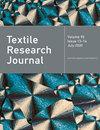Linear regression analysis of properties related to moisture management using cotton–polyester knitted fabrics
IF 1.9
4区 工程技术
Q2 MATERIALS SCIENCE, TEXTILES
引用次数: 0
Abstract
The complex evaluation of thermo-physiological comfort for a particular garment is still challenging, as it depends on the different structural parameters and individual properties of textiles. Measurement of relevant fabric characteristics requires very specific laboratory equipment, such as an M 290 moisture management tester (SDL ATLAS) or similar. For this reason, it is obvious that there is a great demand to predict the overall moisture management capability ( OMMC) based on the individual properties that are responsible for clothing comfort and testing according to different standards rather than OMMC-specific calculation using the M 290 tester. Therefore, in this research, linear regression analysis was performed using MATLAB software to predict the OMMC for cotton–polyester fabrics knitted in two patterns, namely 1 × 1 rib and half-Milano rib, using four percentages of fibers. Water vapor permeability, water vapor resistance, water absorption capacity, water absorption time, and air permeability were used as input variables for linear regression analysis to predict the OMMC of fabrics. The performed analysis has shown that the OMMC is directly dependent on the relative water vapor permeability and air permeability, and the linear regression equation suggested in this research can predict the suitability of a textile for a particular garment concerning its moisture management behavior.利用棉-聚酯针织物对与湿度管理有关的特性进行线性回归分析
对特定服装的热生理舒适性进行复杂的评估仍具有挑战性,因为这取决于纺织品的不同结构参数和个别特性。相关织物特性的测量需要非常特殊的实验室设备,如 M 290 湿度管理测试仪(SDL ATLAS)或类似设备。因此,根据不同的标准和测试对服装舒适性负责的单项特性来预测整体湿度管理能力(OMMC),而不是使用 M 290 测试仪进行特定的 OMMC 计算,显然有很大的需求。因此,在本研究中,使用 MATLAB 软件进行线性回归分析,以预测棉-涤纶织物的 OMMC,该织物采用两种模式,即 1 × 1 罗纹和半米拉诺罗纹,使用四种百分比的纤维。水蒸气渗透率、水蒸气阻力、吸水能力、吸水时间和透气性被用作线性回归分析的输入变量,以预测织物的 OMMC。分析结果表明,OMMC 直接取决于相对透湿性和透气性,本研究提出的线性回归方程可以预测纺织品的湿度管理行为是否适合特定服装。
本文章由计算机程序翻译,如有差异,请以英文原文为准。
求助全文
约1分钟内获得全文
求助全文
来源期刊

Textile Research Journal
工程技术-材料科学:纺织
CiteScore
4.00
自引率
21.70%
发文量
309
审稿时长
1.5 months
期刊介绍:
The Textile Research Journal is the leading peer reviewed Journal for textile research. It is devoted to the dissemination of fundamental, theoretical and applied scientific knowledge in materials, chemistry, manufacture and system sciences related to fibers, fibrous assemblies and textiles. The Journal serves authors and subscribers worldwide, and it is selective in accepting contributions on the basis of merit, novelty and originality.
 求助内容:
求助内容: 应助结果提醒方式:
应助结果提醒方式:


